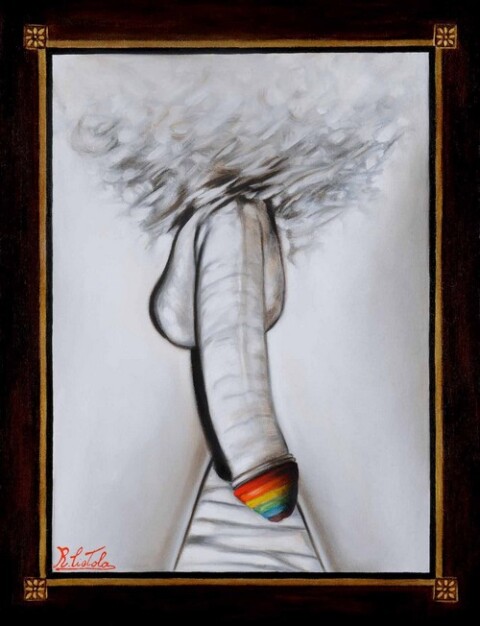"Art is a gift, not a business. Artists should not have to pay to make their creativity known. Just as musicians don't pay to be heard, painters and visual artists deserve to be seen without facing additional costs. Their art is a treasure for everyone, and the world should be able to appreciate it without economic barriers. The visibility of artists should be natural, just like their talent."
ART AGAINST HOMOPHOBIA''THE WHITE PHALLUS''
Work of art by Maestro Raffaele Ciotola

The vision of this pictorial work immediately leads to ascertaining its singularity and apparent provocation, if it is not included in the ''Stop Homoph Art'' artistic current.
In fact, a pornographic implication is to be excluded, as it is a representation that clearly refers to the homosexual issue due to the presence of the colors of the GLBT flag.
Generally, representations centered on male sexuality were in the recent past considered obscene and even today they can arouse discomfort or annoyance even to the most tolerant and less puritanical people.
But, in fact, it would be enough to think of how numerous and commonly spread the representations of the male member were in ancient art, from Egyptian to Greek and Roman art, which did not necessarily have an erotic or sexual reference, but could very often express a idea of fertility and fecundity.
For example, the iconography of the god Dionysus with his orgiastic procession and ithyphallic representations not only alluded to virility and strength, but could also have apotropaic purposes.
In this case, the artist has portrayed a penis, of considerable size, relaxed and milky, with the scrotal sac in an upper position, on a completely white background, to indicate with this chromatic neutrality that the message resides in the colors of the Rainbow Flag.
The prominent and polychrome end almost seems to indicate and trace a track, a new road towards an open and tolerant society.
This work by R. Ciotola, more than any other, surprising us, manages to shake us from our torpor, "stings" our sensitivity through the uncanny impact with reality.
All of this takes place in a dimension of symbolic mediation, which shuns an aesthetic of repulsion, avoiding the apology of the ugly or disgusting, and which has the sole purpose of externalizing and reaffirming the values of freedom and respect.
Prof. Michela Marconi

Raffaele Ciotola was born in Naples on the 17th of October 1964. His loving and receptive family promoted his studies and supported supporting his artistic nature. He obtained the Artistic High School School graduation and got the Master of Arts degree at the state institute of Arts "F.Palizzi" in Naples in 1983. Since he was a boy he has been devoting his life to painting in a professional manner; after his debut in 1980 at an exhibition in his hometown, he kept on taking part in other collective and personal exhibitions set up in several Italian cities until 2002 (Piano di Sorrento, St. Anne in Naples, Milano, Viterbo, Milan). He was awarded the gold medal at the National Biennial of Sacred Art in Torre del Greco in 1980 by prof. Mr Franco Girosi, a famous Neaolitan artist of the last century. It was foundamental for his training, the meetings with prof. Mr Franco Girosi and with Mr Luigi Signore, an artist known as one of the best sculptors of cribs in Italy today. He studied music and attended the voice class at the Conservatory of Naples, but the meeting he had in Rome in 1987 with Master Mr Renato Guelfi, opera singer and painter, was so crucial to his professional growth that he started performing as a singer in some Italian theatres (Lecce, Santa Maria di Leuca, Ronciglione, Villa Pignatelli in Naples). He got to obtained some rewards such as: the gold medal in "La Triade" Prize, Palazzo Sormani - Sala del Grechetto - Milano; the diploma of honor at St. Anastasia, Naples. His personal exhibition in Tuscia dates back to 2002 , in this occasion he exhibited for the first time at the Sala Anselmi in Viterbo. His painting style and production are characterized by an intense use of colours and by the chiaroscuro effects conveying a whole creative freedom and a boundless vital energy, without hiding any strong and eloquent emotion, leaving the viewer a hope, a light , the one that leads beyond any solitude and that blurs roles and social conventions. In fact, from the late 90s, his work is more focused on topical issues and feels the effect of his civil commitment against homophobia and discriminatory behaviors, so it became a vehicle to spread some nonconformist messages, even inspired by universal ethical values. In 2003 he created the artistic movement called "Stop Homoph Art" which aims to spread the culture of respect and fight against homophobia. From this battle, "The Madonna of the homosexuals" came to life, it became the emblematic work of his production and will be exhibited for the first time in the foyer of the Mercadante Theater in Naples on the 18th of October 2014. So his landscapes and his dreamlike hermetic metaphysical views of the first period, they have been gradually replaced by works full of reflection and judgment which are well received by public and by critics, attracting the attention of Mr Jean-Louis Cougnon, Chief Excecutive at General Managment of European Parliament.
Contact
E-mail: maestror.c@gmail.com
* TusciaWeb - The work '' MAOMETTO '' dedicated to all the Muslim community.
* Tuscia Web - The '' COVID-19 '' work dedicated to all the victims of the Coronavirus.
* The work of art " Italy against racism " dedicated to the fight against "racism" which was appreciated by correspondence by the President of the Italian Republic Sergio Mattarella.
* '' San Bonaventura da Bagnoregio '' the work is exhibited in the Co-Cathedral of Saints Nicola, Donato and Bonaventura - Bagnoregio - Viterbo.
* The work of art '' Our Lady of Fátima '' is OFFICIALLY part of the Fátima Museum COLLECTION.
* Catalog of the international artists of Tuscia - Viterbo - Italy.
* Book '' Raffaele Ciotola and his vitalism '' Ediz. Mondadori, Feltrinelli, IBS, University bookstore.
Raffaele Ciotola nasce a Napoli il 17 ottobre 1964 da una madre attenta e sensibile che promuove i suoi studi, assecondando la sua indole artistica. Consegue il diploma di maturità artistica e quello di Maestro d'Arte all'istituto Statale d'Arte "F.Palizzi" di Napoli nel 1983. Fin da giovanissimo si dedica alla pittura in modo professionale e, dopo aver esordito nel 1980 in occasione di una mostra collettiva nella sua città natale, proseguirà partecipando ad altre collettive e personali in numerose città italiane fino al 2002 (Piano di Sorrento, S.Anna a Napoli, Miano, Viterbo, Milano). Viene premiato dal prof. Franco Girosi, insigne artista napoletano del secolo scorso, con la medaglia d'oro alla Biennale Nazionale di Arte sacra a Torre del Greco nel 1980. Fondamentali per la sua formazione gli incontri con il prof. Girosi e con l'artista Luigi Signore, considerato al momento tra i migliori scultori presepiali in Italia. Intraprende gli studi musicali, frequentando il corso di canto presso il Conservatorio di Napoli, ma l'incontro avvenuto a Roma nel 1987 con il maestro Renato Guelfi, cantante lirico e pittore, sarà determinante per la sua crescita professionale, tanto da portarlo ad esibirsi come cantante in alcuni teatri nazionali (Lecce, S.Maria di Leuca, Ronciglione, Villa Pignatelli a Napoli). Tra i riconoscimenti a lui attribuiti, si menzionano: la medaglia d'oro al Premio "La Triade", Palazzo Sormani - Sala del Grechetto - Milano; il diploma d'onore a S.Anastasia, Napoli. Al 2002 risale la mostra personale nella Tuscia, in occasione della quale espone per la prima volta alla Sala Anselmi di Viterbo. Il suo stile pittorico e la sua produzione si contraddistinguono per l'uso intenso del colore e per gli effetti chiaroscurali, esprimendo una libertà creativa ed un'energia vitale smisurata, senza nascondere emozioni forti ed eloquenti, lasciando a chi osserva una speranza, una luce, quella che conduce oltre la solitudine sfumando ruoli e convenzioni sociali. Infatti, dalla fine degli anni '90, la sua attività si concentra maggiormente su temi di attualità e risente dell'impegno civile speso contro l'omofobia e i comportamenti discriminatori, rendendosi propugnatore di messaggi anticonformisti, tuttavia ispirati da valori etici universali. Nel 2003 crea il movimento artistico "Stop Homoph Art" che si prefigge di diffondere la cultura del rispetto e della lotta contro l'omofobia. Da questa sua battaglia nasce "La Madonna degli omosessuali", divenuta l'opera emblematica della sua produzione, che per la prima volta sarà esposta al teatro Mercadante di Napoli il 18 ottobre 2014. È così che ai paesaggi e alle visioni oniriche, a quelle ermetiche e metafisiche della prima fase, si sostituiscono opere di riflessione e giudizio, che vengono ben accolte dal pubblico e dalla critica, suscitando anche l'attenzione di Jean-Louis Cougnon, Capo Divisione presso la Direzione generale del Parlamento Europeo.
